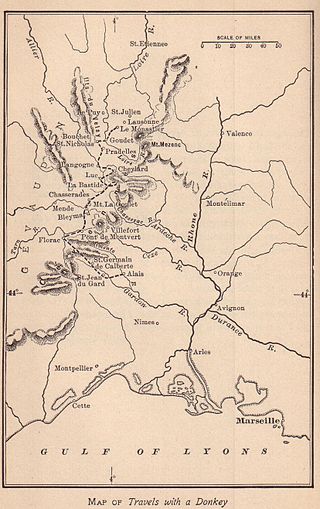
Aigues-Mortes is a commune in the Gard department in the Occitania region of southern France. The medieval city walls surrounding the city are well preserved. Situated on the junction of the Canal du Rhône à Sète and the Chenal Maritime to Le Grau-du-Roi, the town is a transit center for canal craft and Dutch barges.
Camisards were Huguenots of the rugged and isolated Cévennes region and the neighbouring Vaunage in southern France. In the early 1700s, they raised a resistance against the persecutions which followed Louis XIV's Revocation of the Edict of Nantes, making Protestantism illegal. The Camisards operated throughout the mainly Protestant Cévennes and Vaunage regions including parts of the Camargue around Aigues Mortes. The revolt broke out in 1702, with the worst of the fighting continuing until 1704, then skirmishes until 1710 and a final peace by 1715. The Edict of Tolerance was not finally signed until 1787.

The Cévennes is a cultural region and range of mountains in south-central France, on the south-east edge of the Massif Central. It covers parts of the départements of Ardèche, Gard, Hérault and Lozère. Rich in geographical, natural, and cultural significance, portions of the region are protected within the Cévennes National Park, the Cévennes Biosphere Reserve (UNESCO), as well as a UNESCO World Heritage Site: Causses and the Cévennes, Mediterranean agro-pastoral Cultural Landscape. The area has been inhabited since 400,000 BCE and has numerous megaliths which were erected beginning around 2500 BCE. As an agriculturally-rich area, but not a suitable location for cities, the Cévennes developed a wide diversity of pastoral systems, including transhumance. The irrigation and road networks put in place in the early Middle Ages for these pastoral systems are still in use today.

Cévennes National Park is a French national park located in Southern France, in the mountainous area of Cévennes.

Le Vigan is a commune in the Gard department in southern France. It is a sub-prefecture of the department.

Florac is a former commune of the Lozère department in southern France. On 1 January 2016, it was merged into the new commune of Florac-Trois-Rivières.

Le Pont-de-Montvert is a former commune in the Lozère département in southern France. On 1 January 2016, it was merged into the new commune of Pont-de-Montvert-Sud-Mont-Lozère.

Travels with a Donkey in the Cévennes (1879) is one of Robert Louis Stevenson's earliest published works and is considered a pioneering classic of outdoor literature.

François de Langlade du Chayla was the French Catholic Abbé of Chaila, Archpriest of the Cevennes and Inspector of Missions of the Cevennes. His brutal repression of French (Protestant) Huguenots by means of torture caused his assassination and sparked the War of the Camisards.

Le Monastier-sur-Gazeille is a commune in the Haute-Loire department in south-central France.

Cheylard-l'Évêque is a commune in the Lozère department in southern France.

Saint-Germain-de-Calberte is a commune in the Lozère department in southern France.

Saint-Étienne-Vallée-Française is a commune in the Lozère department in southern France.

Mont Lozère is the highest peak in the Cévennes, a subrange of the Massif Central in France. It is 1,699 metres (5,574 ft) above sea level and lies within the Cévennes National Park.

Saint-André-de-Lancize is a commune in the Lozère department in southern France.

Cassagnas is a commune in the Lozère department in southern France.

Saint-Julien-d'Arpaon is a former commune in the Lozère department in southern France. On 1 January 2016, it was merged into the new commune of Cans-et-Cévennes. Its population was 93 in 2019.

Mialet is a commune in the Gard department in southern France.

Le Bouchet-Saint-Nicolas is a commune in the Haute-Loire department in south-central France.

The GR 70, also known as the Chemin de Stevenson or the Robert Louis Stevenson Trail, is a Grande Randonnée that runs for approximately 225 kilometres (140 mi) through the French departments of Haute-Loire, Lozère and Gard in a generally north–south direction from Le Monastier-sur-Gazeille to Saint-Jean-du-Gard. It follows approximately the route taken by Robert Louis Stevenson in 1878, a journey described in his book Travels with a Donkey in the Cévennes.























